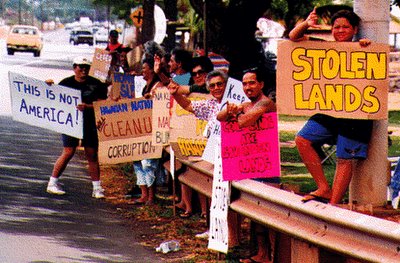 It is easy to find the courage necessary to support a moral position if that position benefits oneself. True moral courage, however, is proven when one chooses to support that which is morally and ethically right even when such a position is to one's one detriment. The people of the United States may just find themselves in such a position right now, forced to choose between a moral and ethical position that carries with it the potential for "inconvenience", or supporting the status quo and having to admit to themselves that they are not the champions of justice they imagine themselves to be. By the end of this posting, you will know for yourself which one you are…
It is easy to find the courage necessary to support a moral position if that position benefits oneself. True moral courage, however, is proven when one chooses to support that which is morally and ethically right even when such a position is to one's one detriment. The people of the United States may just find themselves in such a position right now, forced to choose between a moral and ethical position that carries with it the potential for "inconvenience", or supporting the status quo and having to admit to themselves that they are not the champions of justice they imagine themselves to be. By the end of this posting, you will know for yourself which one you are…Most people know that Hawaii is a state, the 50th state of the United States of America. Most people, including those who live in Hawaii, accept that statement as a fact. But the reality is that our world is bound by the rule of law, and legally speaking, the truth may be quite different!
The truth is that each and every step along Hawaii's path from sovereign and independent nation, to annexed territory, to statehood, was accomplished in violation of laws and treaties then in effect, without regard to the wishes of the Hawaiian people. Many people, including President Grover Cleveland, opposed the annexation of Hawaii.
But in the end, simple greed and military interest overrode any concerns or moral right and legality. Hawaii's legitimate government was toppled using threat of American military force. Hawaii was stolen from her people for the benefit of wealthy American plantation owners and military interests, and the justifications for the crime were invented after-the-fact.
Hawaii's government was overthrown on Jan. 17, 1893, by a relatively small group of men, most of them American by birth or heritage, who seized control of the Islands with the backing of American troops sent ashore from a warship in Honolulu Harbor. To this "superior force of the United States of America," Queen Lili`uokalani yielded her throne, under protest, in order to avoid bloodshed, trusting that the United States government would right the wrong that had been done to her and the Hawaiian people.
Who were this group of American men? Why did they overthrow the government? The answers are businessmen and Sugar!

Sugar was by far the principal support of the islands, profits and prosperity hinged on favorable treaties with the United States, Hawaiian sugar's chief market, creating powerful economic ties. The plantation owners were, for the most part, the descendents of the original missionary families who had brought religion to the islands in the wake of the whaling ships. As ownership of private property came to the islands, the missionary families wound up owning a great deal of it!
Hawaii has little in the way of mineral wealth, so the land was useful only for agriculture. In a day when unrefridgerated sailing ships were the only means to ship produce to the US Mainland, sugar, and to a lesser extent coconuts, were the only produce which could survive the duration of the sea voyage.
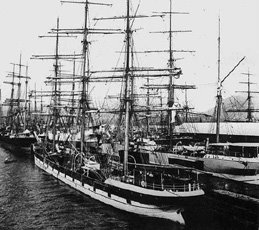 But the United States had, in 1826, recognized Hawaii as a sovereign nation in its own right, and imposed the usual import tariffs on sugar coming from the islands. This cut into the profits of the sugar plantations. Indeed, being American citizens themselves, the plantation owners were rankled by the fact that the US government actually made more profit from their sugar then the plantation owners themselves did! To evade the tariff, it became necessary to the plantation owners that Hawaii cease being a separate and sovereign nation.
But the United States had, in 1826, recognized Hawaii as a sovereign nation in its own right, and imposed the usual import tariffs on sugar coming from the islands. This cut into the profits of the sugar plantations. Indeed, being American citizens themselves, the plantation owners were rankled by the fact that the US government actually made more profit from their sugar then the plantation owners themselves did! To evade the tariff, it became necessary to the plantation owners that Hawaii cease being a separate and sovereign nation.In 1887, during the reign of Lili`uokalani' s brother, King Kalakaua, a group of planters and businessmen, seeking to control the kingdom politically as well as economically, formed a secret organization, the Hawaiian League. Membership (probably never over 400, compared to the 40,000 Native Hawaiians in the kingdom) was predominantly American, led by Lorrin A. Thurston, a lawyer and missionary grandson.
Their goal, was to "reform" the monarchy. But what was "reform" to the Americans was treason to the people of Hawaii, who loved and respected their monarchs.
It is important to recall that, unlike the hereditary rulers of Europe, Hawaii's last two Kings were actually elected to that office by democratic vote. Kalakaua and his sister Lili`uokalani were well-educated, intelligent, skilled in social graces, and equally at home with Hawaiian traditions and court ceremony. Above all, they were deeply concerned about the well-being of the Hawaiian people and maintaining the independence of the kingdom. They saw no reason to relinquish their independence solely to make already rich Americans richer still. Another interesting note is that the Hawaiian Royal Palace (see Photo) Iolani Palace, which was the home of the Hawaiian monarchs had electricity and telephones ten years before the American White House did.
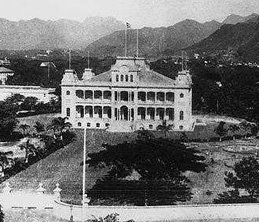
The Hawaiian League's more radical members favored the king's abdication, and one even proposed assassination. But they decided that the king would remain on the throne but with his power sharply limited by a new constitution of their making. Killing him would be a last resort if he refused to agree. Many Hawaiian League members belonged to a volunteer militia, the Honolulu Rifles, which was officially in service to the Hawaiian government, but was secretly the Hawaiian League's military arm.
Kalakaua was compelled to accept a new Cabinet composed of league members, who presented their constitution to him for his signature at `Iolani Palace. The reluctant king argued and protested, but finally signed the document, which became known as the Bayonet Constitution, as in "signed at the point of". As one Cabinet member noted, "Little was left to the imagination of the hesitating and unwilling sovereign, as to what he might expect in the event of his refusal to comply with the demands made upon him."
The Bayonet Constitution greatly curtailed the king's power, making him a mere figurehead. It placed the actual executive power in the hands of the Cabinet, whose members could no longer be dismissed by the king, only by the Legislature. Amending this constitution was also the exclusive prerogative of the Legislature. The Bayonet Constitution's other purpose was to remove the Native Hawaiian majority's dominance at the polls and in the Legislature. The righteous reformers were determined to save the Hawaiians from self-government.
The privilege of voting was no longer limited to citizens of the kingdom, but was extended to foreign residents -- provided they were American or European. Asians were excluded -- even those who had become naturalized citizens. The House of Nobles, formerly appointed by the king, would now be elected, and voters and candidates for it had to meet a high property ownership or income requirement -- which excluded most of the Native Hawaiians. While they could still vote for the House of Representatives, to do so they had to swear to uphold the Bayonet Constitution.
The Hawaiians strenuously opposed the diminution of their voice in governing their own country and resented the reduction of the monarch's powers and the manner in which the Bayonet Constitution had been forced on him. Hawaiians, Chinese and Japanese petitioned the king to revoke the constitution. The self-styled Reform Cabinet responded that only an act of the Legislature could do this - though their new constitution had never been put to a vote.
In 1889 a young part-Hawaiian named Robert W. Wilcox staged an uprising to overthrow the Bayonet Constitution. He led some 80 men, Hawaiians and Europeans, with arms purchased by the Chinese, in a predawn march to `Iolani Palace with a new constitution for Kalakaua to sign. The king was away from the palace, and the Cabinet called out troops who forcibly put down the insurrection. Tried for conspiracy, Wilcox was found not guilty by a jury of Native Hawaiians, who considered him a folk hero.
On Jan. 20, 1891, King Kalakaua died of kidney disease at age 54, leaving his sister, Lili`uokalani' as Queen of Hawaii, who childless herself, declared the young Princess Ka`iulani her successor to the throne. Just 7 months later, Lili`uokalani' s husband, John Dominis, an American sea captain's son, also died, a mysterious death due to an odd stomach ailment.
The next year, Lorrin Thurston and a group of like-minded men, mostly of American blood, formed an Annexation Club, plotting the overthrow of the queen and annexation to the United States. Thurston went to Washington to promote annexation, and received an encouraging message from President Benjamin Harrison: "You will find an exceedingly sympathetic administration here."
On Jan. 14, 1893 the queen attempted to proclaim a new constitution restoring power to the throne and rights to the Native Hawaiian people.
Alerted earlier of the queen's intention by two of her Cabinet members, the Annexation Club sprang into action. A 13-member Committee of Safety was chosen to plan the overthrow of the queen and the establishment of a provisional government. As they plotted revolution, they claimed that the queen, by proposing to alter the constitution, had committed ''a revolutionary act."
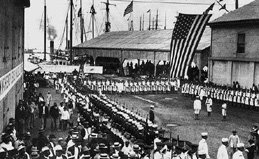 The American warship USS Boston was in port at Honolulu Harbor. With an eye toward landing troops, Lorrin Thurston and two others called upon the American minister in Hawaii, John L. Stevens, an avowed annexationist. Stevens assured them he would not protect the queen, and that he would land troops from the Boston if necessary "to protect American lives and property." He also said that if the revolutionaries were in possession of government buildings and actually in control of the city, he would recognize their provisional government. It is important to note that Stevens lacked any legal standing to recognize a new government on behalf of the United States.
The American warship USS Boston was in port at Honolulu Harbor. With an eye toward landing troops, Lorrin Thurston and two others called upon the American minister in Hawaii, John L. Stevens, an avowed annexationist. Stevens assured them he would not protect the queen, and that he would land troops from the Boston if necessary "to protect American lives and property." He also said that if the revolutionaries were in possession of government buildings and actually in control of the city, he would recognize their provisional government. It is important to note that Stevens lacked any legal standing to recognize a new government on behalf of the United States.The next day, Jan. 15, Thurston told the queen's Cabinet that the Committee of Safety would challenge her, he also delivered a letter to Minister Stevens requesting him to land troops from the Boston, stating that "the public safety is menaced and life and property are in peril." This was a critical point. The "public safety" was threatened only by the Committee of Safety itself. Stevens had no legal basis to send American troops ashore in force. It was, by any definition of the word, an invasion using American troops, in order to overthrow a foreign government.
The Committee of Safety offered the presidency of the provisional government to Sanford B. Dole, another of the "mission boys," as Thurston called them. Rather than abolishing the monarchy, Dole favored replacing the queen with a regency holding the throne in trust until Princess Ka'iulani came of age. He accepted the presidency and submitted his resignation as a justice in Hawaii's Supreme Court.
On the morning of Jan. 17, Dole gave Stevens a letter from Thurston, asking for his recognition of the provisional government, which they planned to proclaim at 3 that afternoon. The American minister told Dole, "I think you have a great opportunity."
On Jan. 17, 1893, at dusk, Queen Lili`uokalani yielded her throne under protest, with these words:
"I, Lili`uokalani, by the grace of God and under the constitution of the Hawaiian Kingdom, Queen, do hereby solemnly protest against any and all acts done against myself and the constitutional government of the Hawaiian Kingdom by certain persons claiming to have established a Provisional Government of and for this Kingdom.
"That I yield to the superior force of the United States of America, whose Minister Plenipotentiary, His Excellency John L. Stevens, has caused United States troops to be landed at Honolulu and declared that he would support the said Provisional Government.
"Now, to avoid any collision of armed forces and perhaps loss of life, I do, under this protest, and impelled by said forces, yield my authority until such time as the Government of the United States shall, upon the facts being presented to it, undo the action of its representative and reinstate me in the authority which I claim as the constitutional sovereign of the Hawaiian Islands."
Note that the queen surrendered Hawaii's sovereignty not to the revolutionaries but to the "superior force of the United States of America". This firmly put the United States in the legal position of having invaded and overthrown the government of a foreign nation without provocation.
The provisional government took over the palace and declared martial law. Later, at its request, Minister Stevens proclaimed Hawaii a temporary protectorate and raised the American flag over government buildings. He wrote the State Department urging annexation, saying, "The Hawaiian pear is now fully ripe, and this is the golden hour for the United States to pluck it."
The provisional government had chartered a steamer, and Thurston and four others hastened to Washington with a treaty of annexation in hand. The queen's envoys were refused permission to sail on the same ship, and by the time they reached Washington, President Harrison had already sent the annexation treaty to the Senate.
But Harrison was in his last days in power, and Grover Cleveland, who replaced him, withdrew the treaty, alarmed by the legal ramifications of what had happened.
President Cleveland sent to Honolulu special commissioner James H. Blount, former chairman of the House Committee on Foreign Affairs. Blount's job was to investigate the circumstances of the revolution, the role Minister Stevens and American troops played in it, and to determine the feelings of the people of Hawaii toward the provisional government. Blount immediately ordered the troops back to their ship and the American flag taken down and replaced by the Hawaiian flag.
Please join us tomorrow for the rest of this interesting tale.
I'm Average Joe
mailto:OurWeirdWorld@gmail.com

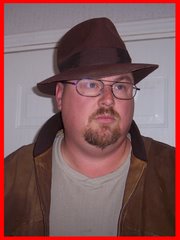
No comments:
Post a Comment